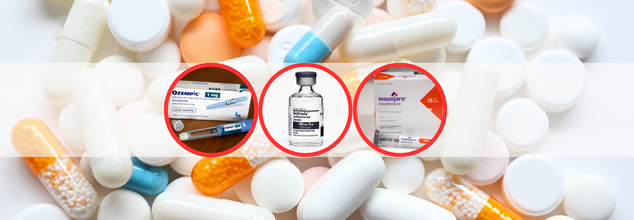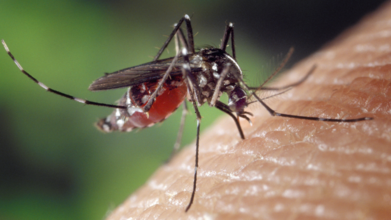- Health Conditions A-Z
- Health & Wellness
- Nutrition
- Fitness
- Health News
- Ayurveda
- Videos
- Medicine A-Z
- Parenting
- Web Stories
Diabetes, Obesity And Cancer: Top 10 Drugs Of 2025 Are Changing How We Fight Disease

Medicine is evolving—and quickly. With chronic diseases surging and scientific innovations accelerating, a new generation of best-selling medicines is revolutionizing the way we treat cancer, diabetes, autoimmune diseases, and obesity. These are not merely pharma successes—these are clinical game changers fueling billions of dollars in investment, research, and optimism.
These most-anticipated drugs in 2025 reflect this shift. Cancer drugs such as Keytruda are raising the bar in oncology, and metabolic medicines such as Ozempic and Mounjaro are transforming the treatment of diabetes and weight. And drugs such as Dupixent and Skyrizi are breaking ground in treating chronic inflammatory diseases, bringing targeted comfort to tens of millions.
The best-selling medications in the world are not only business blockbusters—they are also medical breakouts in the treatment of cancer, diabetes, obesity, and chronic disease. Although sales estimates provide mind-boggling numbers—such as Merck & Co.'s Keytruda poised to exceed $31 billion—the tale behind the tabulation is based on mighty innovations that are transforming how we address some of the globe's most urgent health issues.
The pharma landscape of 2025 is considerably characterized by a focused attempt to address some of the most debilitating and entrenched health issues of our era. Cancer, especially aggressive and difficult-to-treat types such as non-small cell lung cancer, melanoma, and multiple myeloma, continues to remain high on the agenda, with cutting-edge immunotherapies and biologics at the forefront. Simultaneously, increasing worldwide incidence of metabolic disorders like type 2 diabetes and obesity has fueled a new generation of therapies targeted at controlling blood sugar, facilitating weight loss, and lowering cardiovascular risk.
What Diseases are The Main Focus?
Cancer (Oncology)
Cancer is still the biggest and best-funded field in contemporary medicine, with non-small cell lung cancer, melanoma, multiple myeloma, and triple-negative breast cancer ranking high. New immunotherapies and monoclonal antibodies are transforming therapy by educating the immune system to recognize and destroy cancer cells more precisely and with fewer side effects than conventional chemotherapy.
Leading the charge is Keytruda (pembrolizumab), an immunotherapy medication that's transforming cancer treatment. Approved for use to treat several kinds of cancer, including melanoma, non-small cell lung cancer, head and neck cancer, and others, Keytruda functions by strengthening the immune system so it can more effectively find and kill cancer cells. This type of mechanism, referred to as a checkpoint inhibitor, has significantly enhanced survival rates for many aggressive cancers.
Its estimated $31 billion worth of sales in 2025 attests to more than pure economic success—it is a testament to the extent to which immunotherapies have become integrated in oncology therapy worldwide. The rising cancer burden across the world and high growth in the use of immunotherapies in early-stage treatment are among the principal factors propelling its quick ascension.
Type 2 Diabetes
Type 2 diabetes is a metabolic disorder with insulin resistance and persistent hyperglycemia, resulting in long-term damage to the heart, kidneys, and nerves. New drugs not only are enhancing glucose control but also are showing substantial reductions in cardiovascular risks, making them an dual solution for two of the world's top causes of death.
Then come Ozempic and Wegovy, which are trade names for semaglutide, made by Novo Nordisk. The two drugs, though chemically the same, have very different uses. Ozempic is indicated for the treatment of type 2 diabetes, whereas Wegovy is indicated for long-term weight management in people who have obesity or overweight and one or more weight-related conditions.
Semaglutide is a mimic of the GLP-1 hormone, controlling insulin secretion, appetite, and digestion. Its success is representative of the increasing convergence between metabolic health and management of chronic disease. Together, these drugs are expected to account for more than $36 billion in 2025, not just an indication of their medical importance but also of society's increasing interest in the prevention of diabetes and obesity.
Obesity
Obesity is increasingly being seen as a chronic, complex disease rather than merely a matter of lifestyle, and it's firmly connected with diabetes, heart disease, and some types of cancer. New generation weight-loss medications imitate gut hormones to reduce hunger, control blood sugar, and achieve long-term weight loss without surgery.
Eli Lilly's blockbuster, tirzepatide, takes a parallel course with its two brand names, Mounjaro for type 2 diabetes and Zepbound for weight loss. With its novel dual-action mechanism acting on GLP-1 and GIP receptors, it has even more potent appetite suppression and glucose lowering compared to earlier treatments.
Mounjaro's $19.8 billion forecasted sales, combined with Zepbound's $11.3 billion, are testament to the status of tirzepatide as a next-generation therapy for the obesity-diabetes continuum. With obesity as a gateway disease for cancer, cardiovascular disease, and type 2 diabetes, the role of drugs such as these in the preventive sphere cannot be overemphasized.
Chronic Inflammatory Diseases
Diseases like eczema (atopic dermatitis), asthma, nasal polyps, and eosinophilic esophagitis are fueled by hyperactive immune reactions that lead to ongoing inflammation and tissue injury. Biologics for targeted therapies are enabling patients to control these diseases over the long term by silencing particular immune pathways, leading to enhanced quality of life and reduced flare-ups.
Outside of cancer and metabolic disorders, chronic inflammatory and viral diseases also top the list of 10:
Dupixent (dupilumab) is revolutionizing treatment of patients with atopic dermatitis, asthma, and eosinophilic esophagitis by addressing the IL-4 and IL-13 pathway responsible for allergic inflammation. Its estimated $16.9 billion indicates the increasing application of biologics in dermatological and respiratory conditions.
Skyrizi (risankizumab), for plaque psoriasis, psoriatic arthritis, and Crohn's disease, employs IL-23 blockade to decrease systemic inflammation. Its increasing popularity indicates an increased emphasis on fewer side effects and targeted immunomodulators.
HIV/AIDS
Treatment for HIV has improved with once-daily combination tablets that suppress the virus, prevent transmission, and promote near-normal life expectancy. The regimens are now maximized for tolerability and long-term administration, including pediatric and adolescent options.
Biktarvy, which is an HIV drug made by Gilead, combines three antiviral medicines to hold back the virus and make treatment regimens easier. As HIV progresses to become a chronic manageable disease, Biktarvy's projected $13.4 billion sales reflect its place in contemporary, once-daily HIV treatment.
Cardiovascular Disease
The prevention of strokes, blood clots, and heart attacks is a central focus in world health, especially in older adults. Oral anticoagulants are commonly used to treat atrial fibrillation and prevent thromboembolism after surgery or due to chronic disease without the requirement for ongoing blood monitoring.
Eliquis (apixaban), an anticoagulant for stroke prevention and deep vein thrombosis, remains a best-seller. With aging populations and increasing cases of atrial fibrillation, so does demand for safer anticoagulants increase. Its $13 billion forecast confirms the value of preventive cardiology.
COVID-19
Although the pandemic's peak has already gone, innovation in vaccines continues to safeguard susceptible groups and look ahead to future variants. mRNA-based platforms became a template for rapid-response vaccine development, representing a pivot in infectious disease prevention.
At the same time, Comirnaty, the Pfizer-BioNTech COVID-19 vaccine, holds its commercial value at $13.5 billion in anticipated 2025 sales. While demand for vaccination on a worldwide scale has leveled off, booster drives, new strains, and breaking into mRNA-based flu and RSV vaccines keep Comirnaty in worldwide circulation.
Top 10 Drugs Projected by Global Sales in 2025
| Rank | Drug Name | Company | Active Ingredient(s) | Primary Indications | Projected Revenue (in USD billions) |
|---|---|---|---|---|---|
| 1 | Keytruda | Merck & Co. | Pembrolizumab | Melanoma, non-small cell lung cancer, head & neck cancers | $31.0 |
| 2 | Ozempic | Novo Nordisk | Semaglutide | Type 2 diabetes mellitus, cardiovascular risk reduction | $22.3 |
| 3 | Mounjaro | Eli Lilly | Tirzepatide | Type 2 diabetes mellitus | $19.8 |
| 4 | Dupixent | Sanofi | Dupilumab | Atopic dermatitis, asthma, nasal polyposis, eosinophilic esophagitis, prurigo nodularis | $16.9 |
| 5 | Skyrizi | AbbVie | Risankizumab | Plaque psoriasis, psoriatic arthritis, Crohn’s disease | $13.7 |
| 6 | Eliquis | BMS/Pfizer | Apixaban | Stroke prevention, deep vein thrombosis, pulmonary embolism, postoperative thromboprophylaxis | $13.5 |
| 7 | Biktarvy | Gilead | Bictegravir, Emtricitabine, Tenofovir alafenamide | HIV-1 infection | $13.4 |
| 8 | Wegovy | Novo Nordisk | Semaglutide | Chronic weight management (obesity/overweight) | $13.4 |
| 9 | Darzalex | Johnson & Johnson | Daratumumab | Multiple myeloma | $13.2 |
| 10 | Zepbound | Eli Lilly | Tirzepatide | Chronic weight management (obesity/overweight) | $11.3 |
What holds all of these number-one-selling medications together is their evidence of a larger shift in world medicine. The action is more personalized, with gene-targeting and biologics mirroring the old one-size-fits-all approach. There's a discernible trend toward preventive health, where problems like diabetes, obesity, and cardiovascular disease are treated early and aggressively.
Additionally, the triumph of drugs such as Keytruda, Dupixent, and Skyrizi reflects the broadening scope of immune-based treatments, not only in cancer but in dermatology, gastroenterology, and pulmonology. Likewise, the call for metabolic treatments reflects public health efforts addressing global epidemics such as obesity and diabetes.
Though forecasted 2025 revenues of leading medicines present stunning numbers, the actual story involves what these medications are accomplishing for patients. From transforming cancer treatment to allowing long-term weight management, to allowing people with HIV to live longer and healthier—these drugs are milestones in contemporary medicine.
Two Species Of Disease-Carrying Mosquitoes Detected in UK Amid Rising Climate Risks

Credits: Canva
Amid the ongoing Covid-19 scare in the UK, in another news, two species of disease-carrying mosquito have been also found there. These two species are now being found as a result of climate change, scientists too have warned against the same.
Aedes aegypti, also known as the Egyptian mosquito, and Aedes albopictus, also known as the (Asian) tiger or forest mosquito, both known for carrying diseases like yellow fever, dengue, chikungunya, Zika and dirofilariasis have been detected in surveillance traps set by the UK Health Security Agency (UKHSA). This was revealed in the UKHSA peer-reviewd study on invasive mosquito surveillance.
The Egyptian mosquito eggs were detected in a freight storage facility near London's Heathrow Airport, in September 2023- and tiger mosquitoes were detcted in August 2024. This will be the first time that the tiger mosquitoes have been detected since 2019, at a motorway srvice station in Kent.
The study published in research journal PLOS Global Public Health, reported the findings were lead by UKHSA and the Centre for Climate and Health Security.
What Has Changed Now?
Historically, both these species were limited to subtropical and tropical regions, however, among the populations established in southerns and central Europe, the mosquitoes have shown its ability to survive in temperate climates.
Rising temperature is said to be one of the major reasons for incursion of invasive species. This has put new populations at risk of disease transmission.
The authors of the study said, "While there is currently no evidence that Ae. albopictus or Ae. aegypti are widely established in the UK, without timely action, the UK faces the risk of invasive mosquito populations becoming established... proactive measures enhance resilience against emerging vector borne disease risks."
Call To Action
In addition to monitoring at ports and transport hubs across England, Wales and Northern Ireland, the UKHSA has also set up traps in the Kent marshes—considered an ideal spot for mosquitoes to settle due to its warm, wet conditions.
The UKHSA has also run Mosquito Recoding Scheme (MRS). This is a citizen-science project that receives and identifies mosquitoes submitted by members of public, including in response to nuisance biting incidents. Between 2005 and 2021, 286 reports of mosquitoes were submitted to the MRS, all of which were native UK species.
The aim of the scheme is to detect unusual or invasive species of mosquito, so prevention tactics could be put to use.
Collin Johnson, the lead author of the study and a senior medical entomologist at the UKHSA, said for the 2023 and 2024 discoveries: "Each detection triggered enhanced local surveillance and control measures, and the fact that no further specimens were found suggests these were isolated incursions."
"The collaborative efforts between UKHSA, local authorities and landowners were key to rapidly mobilising and preventing the establishment of invasive mosquitoes," he said.
Almost 100 People On Board Royal Caribbean Get Infected By Norovirus

Credits: Canva
More than 90 passengers and crew aboard a Royal Caribbean cruise ship have fallen ill from Norovirus, as per the reports. This ship's final stop was Miami.
The outbreak on the Royal Caribbean was first reported to the US Centers for Disease Control and Prevention (CDC). The ship had departed San Diego on September 19. A total of 94 passenger and 4 crew members were "reported being ill during the voyage," noted the CDC. The main symptoms as per CDC was diarrhea and vomiting.
Other symptoms include muscle ach, abdominal pain, fever, or three or more loose sttols within 24-hour period. From a total of 1,874 passengers and 833 crew, as per the reports, only 4% of people on board were infected, confirmed CDC.
The crew on the ship has increased their cleaning and disinfecting procedures. Stool specimens from gasteointestinal illness have been collected for testing and have been isolated from those who are sick.
In a statement to USA TODAY, the Royal Caribbean said, "The health and safety of our guests, crew, and the communities we visit are our top priority. To maintain an environment that supports the highest levels of health and safety onboard our ships, we implement rigorous cleaning procedures, many of which far exceed public health guidelines."
The Independent reports that the cruise ship also consulted with the Vessel Sanitation Program (VSP), which is remotely monitoring the situation, including review of the outbreak, response, and sanitation procedures.
What Is Norovirus?
As per the CDC, it is a very contagious virus that causes vomiting and diarrhea. It is commonly called the 'stomach flu" or "stomach bug".
However, norovirus illness is not related to the flu. The flu is caused by the influenza virus. Norovirus causes acute gastroenteritis, an inflammation of the stomach or intestines.
Most people with norovirus illness get better within 1 to 3 days; but they can still spread the virus for a few days after.
What Are The Symptoms Of Norovirus?
- Diarrhea
- Vomiting
- Nausea
- Stomach pain
- Fever
- Headache
- Body aches
- Dehydration: If you have Norovirus, you can feel extremely ill and dehydrated and the symptoms can show through decreased urination, dry mouth and throat, feeling dizzy when standing up, crying with few or no tears, unusual sleepiness or fussiness.
Who Is At Risk?
- Anyone can get infected and sick with norovirus.
- People of all ages are affected during norovirus outbreaks.
- Genetic factors can partly determine your likelihood of infection.
- Raw oysters and other filter-feeding shellfish may contain viruses and bacteria that cause illness or even death.
- Eating raw shellfish puts anyone at risk of contracting norovirus.
- Children under 5, older adults, and people with weakened immune systems are more likely to develop severe infections.
US Government Shutdown: What Does It Mean For Health Services?

Credits: AP
The US government shuts down at midnight confirmed Associated Press. The Vice President JD Vance said, "I think we're headed to a shutdown because the Democrats won't do the right thing," after a meeting where Congressional Democrats refused to give Republicans the votes they needed to pass a short-term funding agreement. The Democrats have demanded overhauls to Medicaid cuts and extensions to health care tax credits, something Republicans wish to stay out of.
House Minority Leader Hakeem Jeffries said that Republicans are "divorced from reality". He said, "They just wanted to kick the health care problem down the road."
What Does US Government Shutdown Mean For Health Services?
During a shutdown, only 59% of employees would be working at the Department of Health and Human Services. The rest are to be furloughed, meaning to be discharged from their job.
This means, out of the 47,257 employees who would be kept during the shutdown, only 35,000 would be continued to paid, while 12,000 would work without pay. Around 32,460 Health and Human Services (HHS) employees will be discharged from their work.
For the Centers for Disease Control and Prevention (CDC), only 36% of employees would work, with 15% without pay, also reported by ABC News. At the Food and Drug Administration (FDA), 86% employees would continue to work, with 19% without pay.
What it means for safety guidelines? The FDA's Animal Drugs and Foods Program "would end pre-market safety reviews of novel animal food ingredients for livestock, thus be unable to ensure that the meat, milk, and eggs of livestock are safe for people to eat; activities would be limited to those that address imminent threats to the safety of human life".
The National Institutes of Health would also come down to 24% of employees.
Will Medicare and Medicaid Continue During The US Government Shutdown?
Federal spending's biggest portion which is considered 'mandatory' will remain untouched, including payments by Social Security, Medicare and Medicaid.
While government officials say that payments won't be affected, related services could, however, slow down, including receiving replacement cards and benefit verification services.
This could also threaten around 7 million low-income women and their children who relied on programs like the Women, Infants. and Children (WIC), a US federal program that provides nutritious foods, nutrition education, and referrals to healthcare and social services for low-income pregnant and postpartum women, infants, and children up to the age of 5, who are at nutritional risk.
Ali Hard, who is the policy director for the National WIC Association told ABC News that if a shutdown continues for more than a week, WIC may begin to run out of funds.
Why Is The US Government Shutting Down?
The main crux of it could be the disagreement in the health policies. For the extended funding, which would only be possible through cuts in Medicaid, the Senate voted 55-45 on the measure, which has left Republicans five votes short of 60 vote threshold.
President Donald Trump on this said, "They (Democrats) want to give health care to illegal immigrants, which will destroy health care for everybody else in our country."
Previously it happened during the 2018-2019 shutdown, which lasted for 35 days.
© 2024 Bennett, Coleman & Company Limited

